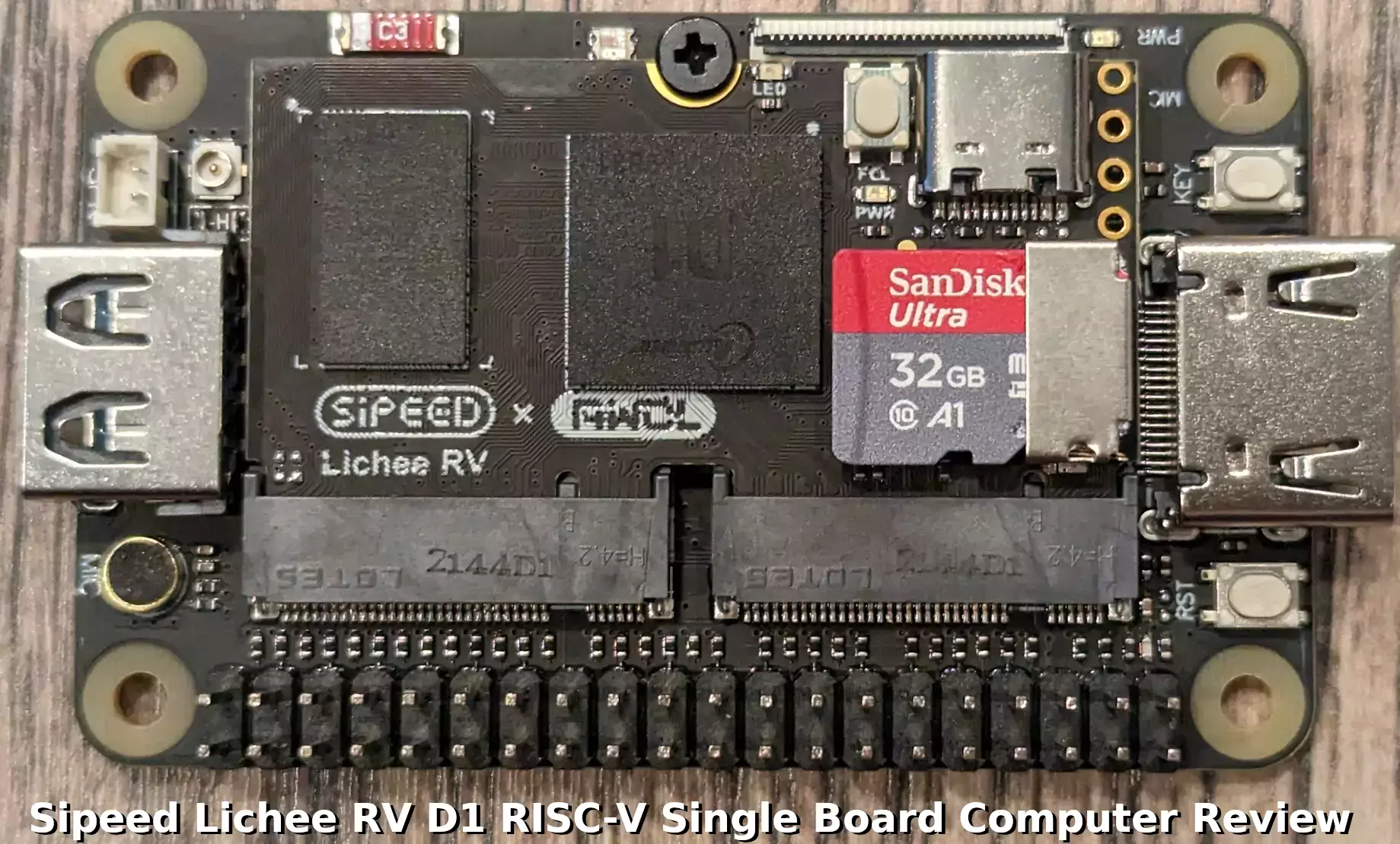
The support for open-source RISC-V hardware continues to improve across the board as more board manufacturers continue to adopt them and ship high quality boards powered by RISC-V. Today we’ll be looking at the Sipeed LicheeRV.
It’s honestly one of the most exciting single board computer products I’ve seen in a while. It’s basically the RISC-V version of a Pi Compute Module! These are small modules that are meant to be used with different docks / IO boards. They can be swapped between the different docks and will gain different capabilities based on what the dock has just like a dock for your laptop / other devices.
Not only that, this board is now officially supported by Ubuntu! Not only do you have an awesome form factor but you now have a very serious mainstream operating system that is supporting the board and architecture. I’ll also benchmark the device and tell you what to expect performance wise.
Let’s get started!
Hardware Used

The LicheeRV Dock runs the RISC-V architecture with a Allwinner D1 1.0 GHz CPU. It uses 2 M.2 connectors side by side as the connection between the dock and the LicheeRV.
Links: Amazon.com*, AliExpress*, Amazon.ca*, Amazon.com.au*, Amazon.co.uk*, Amazon.de*, Amazon.es*, Amazon.fr*, Amazon.it*, Amazon.nl*, Amazon.pl*, Amazon.sg*

The Geekworm copper heatsink set is designed to fit many different single board computers. It uses thermal conductive adhesive which many “cheap” heatsink kits for SBCs don’t have. Eliminates hotspots and reduces throttling. Can be further enhanced by powered cooling over the heatsinks.
Links: Amazon.com*, Amazon.ca*, Amazon.co.jp*, Amazon.co.uk*, Amazon.de*, Amazon.es*, Amazon.fr*, Amazon.it*
Specifications
- CPU
- Allwinner D1 chip (Based on T-Head XuanTie C906 core)
- Up to 1GHZ
- RAM
- 512MB 16bit DDR3
- Up to 792MHz
- Storage
- Onboard SD card slot
- Reserved SD-NAND pads
- Display
- MIPI: 4-lane MIPI DSI
- RGB: RGB888 interface(partially multiplexed with DSI)
- MCU: I80 interface
- SPI: Onboard 8pins SPI screen interface – can be used for 1.14 inch screen
- Audio
- Analog audio headphone output (HP OUT);
- Analog audio line input (LINE IN);
- Digital Audio (I2S/SPDIF);
- Analog microphone interface (MIC3);
- Digital microphone interface (DMIC);
- All above pin out to connecting finger
- Ethernet
- Pin out RMII/RGMII to connecting finger (Multiplexed with some GPIOs)
- USB
- Onboard Type-C USB-OTG interface (USB0)
- USB-HOST pins out to connecting finger (USB1)
- FEL key (Enter download mode)
Build Quality
The build quality is fantastic especially for the price. It uses two M.2 connectors for the board to mount to the dock.
First let’s take a look at the module outside of the dock:
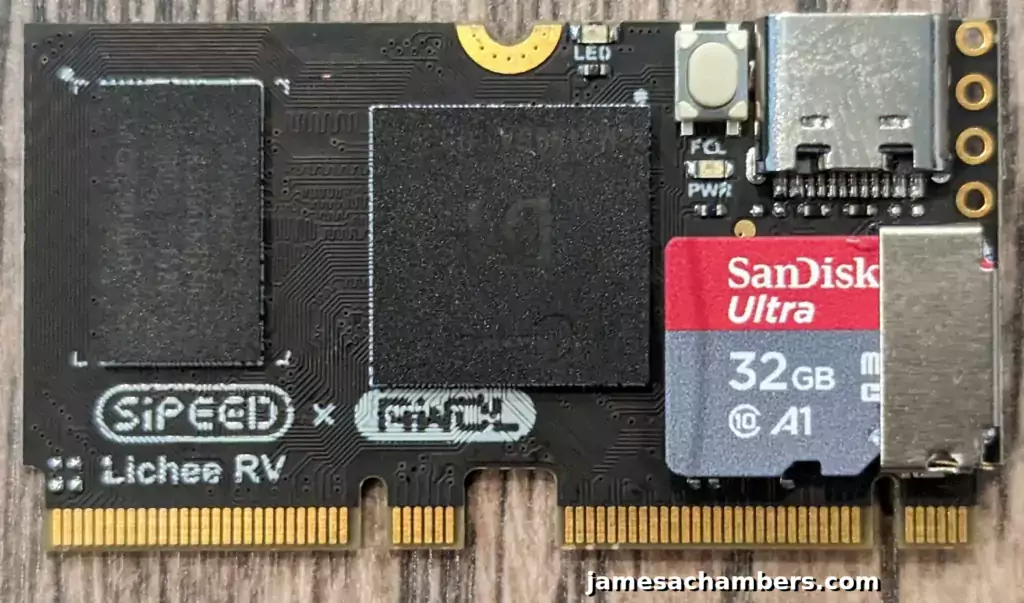
As you can see it’s incredibly small. I left the micro SD card in the device so you could get a sense of how small it actually is. It’s smaller than a Pi Zero. Quite a bit smaller actually.
Here’s a look at the dock without the module inserted:
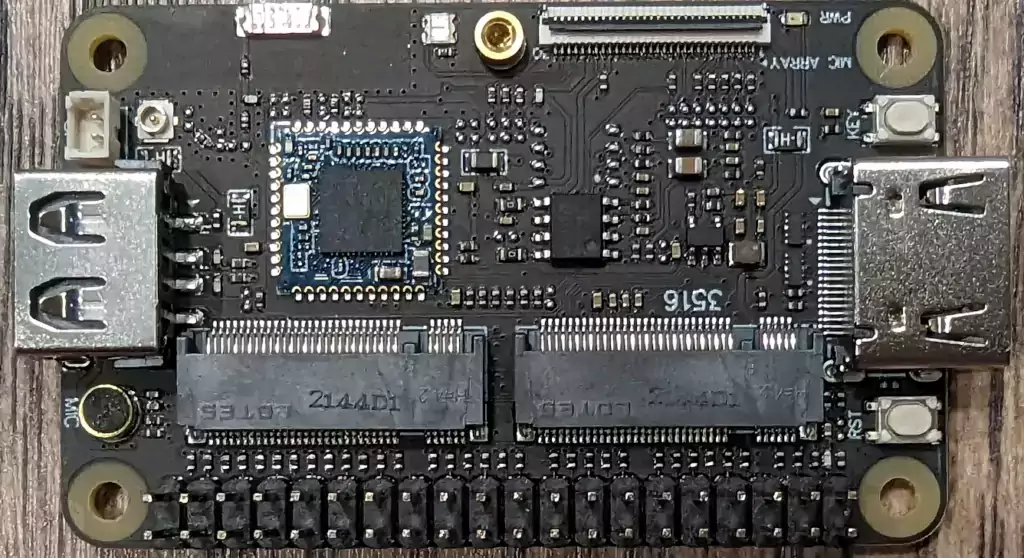
And the bottom of the dock:
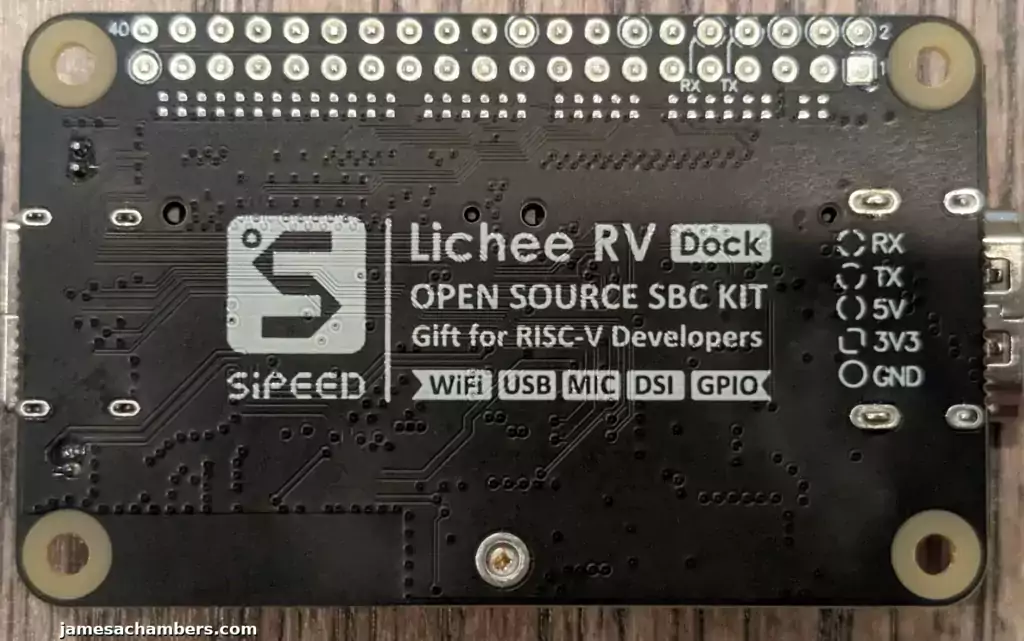
Everything is printed clearly and easy to read. The connectors feel like they can handle a lot of abuse. It’s probably a good thing they went with a standard tried-and-true connector like the M.2 standard.
Images Available
The official image download page for the LicheeRV is here.
The page to download the official Ubuntu RISC-V image with LicheeRV support is here.
The official operating system is Tina Linux which is a very small distribution meant for low power systems. I definitely recommend using the Ubuntu Server image personally and that is what I’ll be testing with today.
Benchmarking I/O Performance
You can verify the performance of your drive on Pi Benchmarks using the following command:
sudo curl https://raw.githubusercontent.com/TheRemote/PiBenchmarks/master/Storage.sh | sudo bash
Here are the results:
Category Test Result
HDParm Disk Read 11.38 MB/s
HDParm Cached Disk Read 11.38 MB/s
DD Disk Write 9.8 MB/s
FIO 4k random read 1521 IOPS (6085 KB/s)
FIO 4k random write 614 IOPS (2456 KB/s)
IOZone 4k read 4458 KB/s
IOZone 4k write 1878 KB/s
IOZone 4k random read 4177 KB/s
IOZone 4k random write 1991 KB/s
Score: 652
The full Lichee RV benchmark can be viewed here on Pi Benchmarks.
This is pretty close to the score the Mango Pi MQ Pro got (another RISC-V board that shares the same D1 processor) . This is exactly where we should be.
Keep in mind that as a single core 1 GHz CPU this board is not meant to handle heavy loads. It is meant for light services and applications essentially.
Connecting to WiFi (persistently) with Ubuntu
First make sure you’ve installed the wireless driver for the Lichee RV with:
sudo apt install licheerv-rtl8723ds-dkms
Note: Building the WiFi driver will take a very long time (over an hour).
Since this is Ubuntu we need to use netplan to set up the WiFi connection. To do this we will edit the file /etc/netplan/50-cloud-init.yaml:
sudo nano /etc/netplan/50-cloud-init.yaml
We are going to modify the file and add the “wifis” section like this:
network:
ethernets:
zz-all-en:
dhcp4: true
match:
name: en*
optional: true
zz-all-eth:
dhcp4: true
match:
name: eth*
optional: true
version: 2
wifis:
wlan0:
optional: true
access-points:
"YourSSID":
password: "YourPassword"
dhcp4: true
Note that the spacing is *extremely* sensitive with YAML. You should paste your code into a YAML validator and make sure you don’t have any spacing errors as they will break the file.
Now let’s apply the netplan configuration with:
sudo netplan --debug generate sudo netplan --debug apply
Now let’s check iwconfig again:
root@ubuntu:/etc/netplan# iwconfig
lo no wireless extensions.
usb0 no wireless extensions.
enx3c18a07c2cb9 no wireless extensions.
wlan0 IEEE 802.11bgn ESSID:"jamesachambers.net" Nickname:"<WIFI@REALTEK>"
Mode:Managed Frequency:2.437 GHz Access Point: 24:5A:XX:XX:XX:XX
Bit Rate:72.2 Mb/s Sensitivity:0/0
Retry:off RTS thr:off Fragment thr:off
Encryption key:****-****-****-****-****-****-****-**** Security mode:open
Power Management:off
Link Quality=0/100 Signal level=-55 dBm Noise level=0 dBm
Rx invalid nwid:0 Rx invalid crypt:0 Rx invalid frag:0
Tx excessive retries:0 Invalid misc:0 Missed beacon:0
You’ve now configured netplan and will persistently connect to the network!
Pros / Cons
Pros
- Can connect to a dock or I/O board similar to a Pi Compute Module 3/4
- Runs RISC-V open hardware
- Officially supported by Ubuntu
- Extremely affordable and available worldwide
Cons
- D1 chip is single core and should be used for light applications/services and not heavy loads
- Not suitable for desktop use
- 512MB of RAM is the only option available
Conclusion
It has really been a personal breakthrough for me that both the LicheeRV and the Mango Pi MQ Pro can run Ubuntu Server really well! I’m sure that the official Tina Linux distribution is fine but I am honestly too used to having the full apt catalog of a larger distro like Ubuntu / Debian available. Once you start using Ubuntu with the RISC-V architecture and everything you expect to be there is there and working making the jump doesn’t seem like such a big deal. I’m really enjoying using these RISC-V boards with Ubuntu!
The entire kit even with the dock is only slightly wider than a Pi Zero. It’s incredibly small outside the dock (smaller than a Pi Zero or a Compute Module) and even works without it (with a limited amount of hardware available but it’s still cool nonetheless)! It’s very exciting to see a RISC-V take on the Compute Module series of boards that have a connector capable of connecting to different docks / IO boards.
I would highly recommend anyone into single board computers gets one of these boards. Even if you’ve only traditionally worked with ARM boards it’s really easy to get into it and get started with one of these LicheeRV dock kits. It will only cost you around $27-$34 or so to get the entire kit. I ordered mine from AliExpress for what it’s worth because it was cheaper. I had to wait longer but I have another half dozen or so boards in the mail anyway so I didn’t mind waiting to save the money.
I have a Lichee RV 86 panel kit* coming soon as well so I will be doing more Lichee coverage on the site here as soon as it arrives and plan to use these for various projects around the house. That is basically a small wall mounted panel powered by the Lichee RV inside it! I want to start setting up some smart sensor and security systems around my house using open source hardware to start phasing out some of my cloud systems I have around the house.
Other Resources
Another RISC-V board that uses the same D1 chip is the Mango Pi MQ Pro. It’s also the most pink board you’ve ever seen.
Make sure you see my Lichee RV 86 Panel guide if you are interested in a screen for your Lichee RV




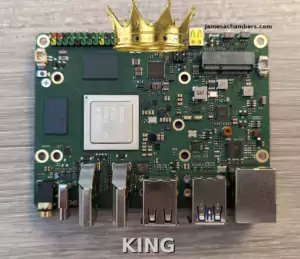

Hey Remote!
Do you plan to bring back Odyssey online? I miss playing with you guys.
Hello Ody Player,
It has been a while since anyone has asked me that! I’d love to bring it back but I’m still in the middle of building up the blog / a business. To give a sense of scale there are maybe hundreds of Odyssey players, maybe even a thousand or a little bit more out there. That is how many users my web site gets per day and it’s still not enough users to be my full time job and I’m relying on other income while I keep building it and creating more content if that makes sense.
Assuming I succeed at some point I’d love to revisit some of my old passion projects. I’d like for it to not be about money when I do it as originally when I was running it back in the day that was the case (when it was at it’s best at least). I still own the domain name odysseyclassic.com (that is actually me) so I definitely haven’t fully let go or given up on doing this some day (I definitely miss it too)!
Enjoy your analysis.
It really leaves something to be desired in performance demanding (CPU-bound) applications.
In terms of values $ it compensates much more than buying the Nezha (which has ethernet) however it is not feasible to use wi-fi/bluetooth being obsolete and exclusive to tinalinux. And the performance result does not differ from lincheerv and MangoPi.
Hey Matheus,
Thank you so much! Absolutely, this is definitely true. The D1 is not a very powerful CPU. The performance result for sure doesn’t differ between the two and my two benchmarks found that. The Mango Pi got 718 and the LicheeRV got 652. I definitely don’t consider that a significant difference. If I ran the benchmark several more times I probably could have closed the gap and got them extremely close but this is normal variance between runs (especially on this slow of a device). They’re both on the very low end of the scale.
I’d love to see more powerful modules though. For example my Lichee RV 86 Panel is supposedly coming with a 1GB Lichee RV module. Apparently these actually exist but I haven’t seen them for sale individually (just the 512MB versions). The point is though that there are already different versions out there. I’ll have a 1GB version soon although I have no idea how you’d get it without buying the Lichee RV 86 panel (and even then it was an extra option, it had the choice of a 512MB or 1GB and I upgraded the one mine came with).
Hopefully there will be modules produced later with a more powerful CPU. That would be a logical next step. Even stepping up to a dual core would make a world of difference as honestly the fact that there is only a single CPU core is more of an issue in my eyes than the CPU core only being clocked at 1GHz. If it had 2 1GHz CPU cores (call it the D2 maybe? That would be awesome) it would feel *so* much better even with that low of a clock speed.
On the MangoPi I was able to get the wireless working (actually by installing the LicheeRV wireless driver which works perfectly on the MangoPi MQ Pro due them sharing rtl8723ds). You need to do the same thing with the Lichee. Do a:
sudo apt search licheeubuntu@ubuntu:~$ sudo apt search licheeSorting... Done
Full Text Search... Done
crust-firmware/kinetic 0.5-2 all
SCP firmware for Allwinner sunxi boards
licheerv-rtl8723ds-dkms/kinetic 1.0-0ubuntu1 riscv64
DKMS package to build Wifi driver for the LicheeRV board
It won’t come with the WiFi driver. I know it because if it did then you wouldn’t have to download it on the MangoPi MQ Pro using the exact same Ubuntu image. The above output is from my Lichee (note that it doesn’t say the package is installed, only available) so I can 100% confirm it comes without the wireless driver. To install it just do:
sudo apt install licheerv-rtl8723ds-dkmssudo modprobe 8723ds
In other words although we can’t make the CPU any faster the wireless is absolutely fixable. Note: installing the WiFi driver will take a *very* long time to build on the Lichee/MangoPi MQ Pro (like over an hour).
This is a fantastic start but I’d love to see some more powerful CPU options as well. Thanks for sharing your thoughts, take care!